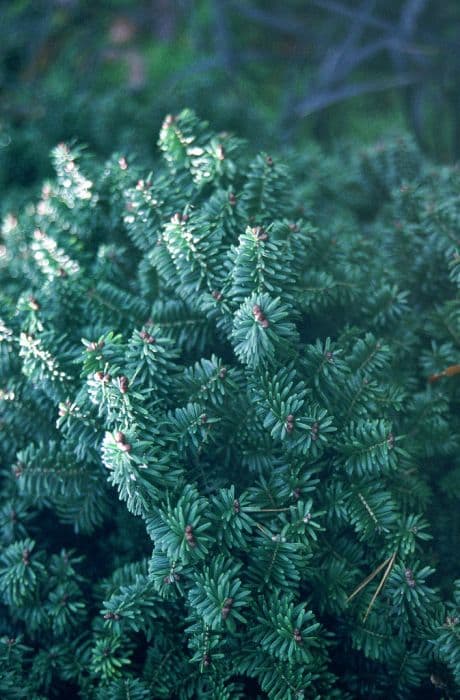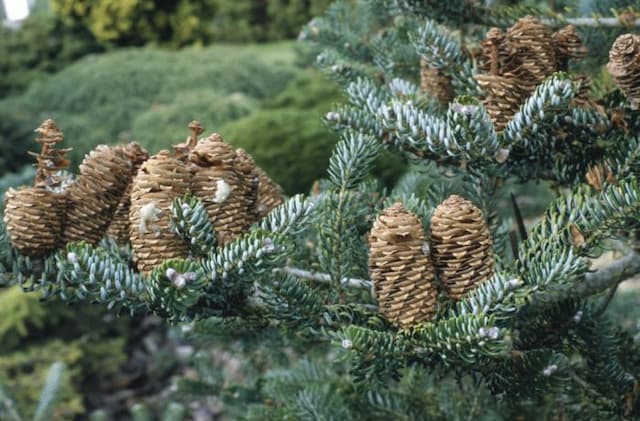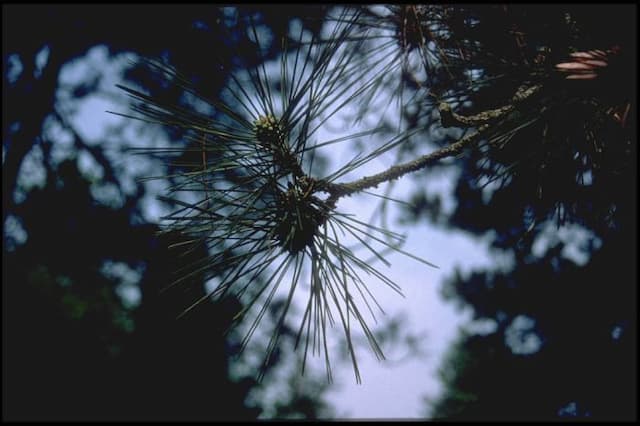Dwarf Siberian Pine Pinus pumila 'Glauca'

ABOUT
Pinus pumila 'Glauca', commonly known as the dwarf Siberian pine or Japanese stone pine, is a compact evergreen shrub-like tree with a bold and textured appearance. Its most striking feature is the bluish-green needles that densely cover the branches, often curved or slightly twisted, which add a splash of cool color to the landscape throughout the year. The needles are arranged in bundles of five, creating a full and fluffy look, which adds to the plant's visual appeal. This cultivar sports a robust, bushy form, with its branches spreading outward in a mounding fashion. The dwarf Siberian pine further embellishes itself with small but prominent cones that start out with a green hue before maturing to a brownish color. The cones are compact and sometimes exhibit a slightly curved shape, which gives the plant additional character among its foliage. Overall, this plant's distinctive coloring, as well as its rounded and dense habit, make it a remarkable choice for gardeners looking to introduce evergreen texture and year-round interest into their gardens without focusing on size. Its resilience to cold conditions is hinted at by its common name, indicating this plant's sturdiness in the face of challenging weather.
About this plant
 Names
NamesFamily
Pinaceae
Synonyms
Dwarf Siberian Pine, Japanese Stone Pine, Siberian Dwarf Pine
Common names
Pinus pumila, Pinus cembra var. pumila, Pinus cembra subsp. pumila, Pinus pumilio.
 Toxicity
ToxicityTo humans
Dwarf Siberian Pine is not commonly known to be toxic to humans. It does not typically contain compounds that are poisonous upon ingestion. However, any plant material may cause a reaction in sensitive individuals or if ingested in large quantities, leading to gastrointestinal discomfort or other non-specific symptoms.
To pets
Dwarf Siberian Pine is generally considered non-toxic to pets. Most pines do not possess toxic compounds that would cause severe poisoning in pets. However, the ingestion of needles can be mechanically irritating and potentially lead to gastrointestinal upset or obstruction, especially in smaller pets. The oils and sap can also cause mild irritation if they come into contact with the skin or fur.
 Characteristics
CharacteristicsLife cycle
Perennials
Foliage type
Evergreen
Color of leaves
Blue-green
Height
3 feet (0.9 meters)
Spread
6 feet (1.8 meters)
Plant type
Shrub
Hardiness zones
4
Native area
Asia
Benefits
 General Benefits
General Benefits- Ornamental Value: Offers year-round visual interest with its compact size, unique blue-green foliage, and conical shape.
- Erosion Control: Its root system helps stabilize soil and prevent erosion on slopes or in rocky areas.
- Low Maintenance: Requires minimal care once established and is tolerant of poor soils, drought, and cold climates.
- Wildlife Habitat: Provides shelter and nesting sites for birds and other small wildlife.
- Windbreak: Can be used in hedges or as a windbreak due to its dense foliage and toleration of harsh conditions.
 Medical Properties
Medical PropertiesThis plant is not used for medical purposes.
 Air-purifying Qualities
Air-purifying QualitiesThis plant is not specifically known for air purifying qualities.
 Other Uses
Other Uses- Pinus pumila, commonly known as Dwarf Siberian Pine, can be used as a bonsai plant due to its compact growth habit which allows for creative miniature tree sculpting.
- The dense wood of Dwarf Siberian Pine can be utilized for making small wood crafts, including carvings, utensils, and ornaments.
- Its robust branches are often used in floral arrangements, wreaths, and as greenery in bouquets for their aesthetic appeal and durability.
- Dwarf Siberian Pine's pine needles can be used as a natural mulch in gardens, providing insulation, moisture retention, and soil erosion prevention.
- The resin from Dwarf Siberian Pine can be used in the production of traditional varnishes and adhesives.
- Its pine cones can be collected and used for decorative purposes, or in arts and crafts projects, such as festive decorations.
- Dwarf Siberian Pine can serve as a windbreak or protective hedge, especially in cold, windy, and mountainous regions where it thrives.
- The tree's ability to survive in harsh conditions makes it valuable for soil stabilization and reclamation projects.
- Dwarf Siberian Pine can be planted in rock gardens for its adaptability to poor soil conditions and its aesthetic, shrubby form.
- The tree can be used in landscape design to create alpine and subalpine garden scenes, mimicking its natural habitat.
Interesting Facts
 Feng Shui
Feng ShuiThe Dwarf Siberian Pine is not used in Feng Shui practice.
 Zodiac Sign Compitability
Zodiac Sign CompitabilityThe Dwarf Siberian Pine is not used in astrology practice.
 Plant Symbolism
Plant Symbolism- Resilience: Pinus pumila 'Glauca', commonly known as the Dwarf Siberian Pine, is known for its ability to withstand tough conditions, symbolizing the strength to endure and overcome challenges.
- Longevity: Dwarf Siberian Pine trees can live for many years, representing long life and persistence.
- Protection: In some cultures, pine trees are considered protective symbols, warding off evil spirits and bad luck, and the Dwarf Siberian Pine is no exception.
- Regeneration: The pine's ability to regrow and regenerate, even after damage or injury, makes it a symbol of recovery and new beginnings.
- Wisdom: Pines are often associated with wisdom and knowledge, as they are ancient species that have existed for a long time.
- Purity: The evergreen nature of the Dwarf Siberian Pine indicates immortality and purity, as the tree remains green throughout the year.
 Water
WaterThe Dwarf Siberian Pine should be watered deeply but infrequently to mimic the natural environment; during the growing season, this may mean watering once every week or two, especially if the weather is dry. When watering, ensure that the soil is moistened to a depth of at least 6 inches, which could be around 1 to 2 gallons for each plant depending on size and soil conditions. During the dormant season, reduce watering to every few weeks unless there is sufficient rainfall. It's important to avoid overwatering, as these pines are adapted to well-drained soils and excess moisture can lead to root rot. Always check the soil moisture level before watering to ensure the plant actually needs it.
 Light
LightThe Dwarf Siberian Pine thrives in full sun conditions, requiring at least six to eight hours of direct sunlight daily. It prefers a location unobstructed by taller trees or structures to receive ample sunlight throughout the day. Partial shade can be tolerated, but this conifer's growth and needle color are most vibrant when it is situated in a spot with maximum sun exposure.
 Temperature
TemperatureThe Dwarf Siberian Pine is hardy and adapts well to cold conditions, tolerating temperatures as low as -50 degrees Fahrenheit. The plant prefers cool summers and can withstand a maximum temperature of around 70 to 75 degrees Fahrenheit. The ideal growing conditions for this conifer are in cooler climates where extreme high temperatures are uncommon.
 Pruning
PruningPruning the Dwarf Siberian Pine is generally done to remove any dead or damaged branches, which helps maintain the plant's health and appearance. Prune in late winter or early spring before new growth begins. This conifer does not need regular shaping; however, any selective pruning to manage its size or shape should be performed during this dormant period to minimize stress on the plant.
 Cleaning
CleaningAs needed
 Soil
SoilThe Dwarf Siberian Pine (Pinus pumila 'Glauca') prospers in well-draining soil with a mix of one part peat, one part pine bark, and one part sand or perlite; it prefers a slightly acidic to neutral pH of 5.5 to 7.
 Repotting
RepottingDwarf Siberian Pine should be repotted every 3 to 4 years to refresh the soil and encourage healthy growth; young, fast-growing plants may require more frequent repotting.
 Humidity & Misting
Humidity & MistingDwarf Siberian Pine thrives in average outdoor humidity levels and does not require specific humidity adjustments when grown in its natural outdoor environment.
 Suitable locations
Suitable locationsIndoor
Ensure bright light, cool temps, and limit watering.
Outdoor
Plant in sunny area with well-draining soil.
Hardiness zone
1-7 USDA
 Life cycle
Life cycleDwarf Siberian Pine 'Glauca' (Pinus pumila 'Glauca') begins its life cycle as a seed that requires well-drained soil and cold stratification to germinate. After sprouting, the seedling grows gradually, developing a deep taproot and sturdy stem; it is tolerant to cold climates but requires full sun for optimal growth. As the plant matures, it forms a dense, spreading shrub with needle-like leaves that have a distinctive blue-green color, characteristic of the 'Glauca' cultivar. The Dwarf Siberian Pine remains relatively small, typically not exceeding 3-5 feet in height, fitting its dwarf stature. It produces pine cones after reaching maturity (around 5-10 years), which then disperse seeds for the continuation of the species. Throughout its life, which can span several decades, the Dwarf Siberian Pine exhibits slow growth and requires minimal maintenance, adapting well to harsh environments and poor soil conditions.
 Propogation
PropogationPropogation time
Spring-Early Summer
Pinus pumila 'Glauca', commonly known as Dwarf Siberian Pine, is typically propagated through seeds, as it is a coniferous plant. The most popular method involves collecting seeds from cones that are produced by the plant. The best time to collect these cones is in late summer or early fall, when they are mature but have not yet opened to release their seeds. These seeds need to be stratified, which means exposing them to a period of cold in order to break their dormancy. This is often done by placing the seeds in a moist substrate, such as sand or peat, and refrigerating them at a temperature between 33 to 40 degrees Fahrenheit (0.5 to 4.4 degrees Celsius) for about 60 to 90 days. After stratification, the seeds can be sown in a well-drained soil mix, under bright conditions but not in direct sunlight, and kept moist until germination, which typically takes a few weeks to a few months depending on conditions. Seedlings should be allowed to grow in their original containers for at least a full season before transplanting to a more permanent location.









